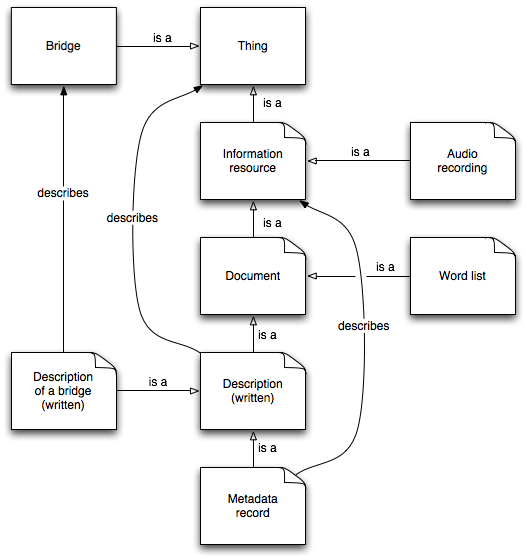The place of metadata
I am entering this picture into the blog mainly so I can refer to it if I need to.
The problem is that people often get confused about these relationships. Maybe I am confused and it’s catching, but I have no evidence of this.
Some people like to talk about “the metadata for a bridge”. That really bothers me. Metadata in common usage (outside of circles of confused informatics weenies) means information about information. Look it up. So what’s really meant is “a description of a bridge” or “data about a bridge”.
Some people like to say that all information resources (document-like things) are descriptions. They aren’t. A symphony isn’t a description, nor is a word list.
The main message is the center axis but the side classes are added to document what another subclass choice would be in each case.
I don’t know much UML but I have picked up one habit, which is to use this kind of arrow (the one whose head looks like a triangle) to mean “is a subclass of” or “is a”. If it were a relation like others you see in diagrams like this where the nodes are classes, the relation would be “equals” where some of the things in the target are not equal to anything in the source. Using a different kind of arrowhead emphasizes the difference in kind. Relation links to me mean “some of these are [label]-related to some of those.” I could use UML or ER detailing (double-arrow and so on) to say whether it’s some or all in each case and whether the relationship is functional or inverse functional, but I don’t because I can never member what those funny annotations mean.
To relate to the FRBR discussion, a BR (bibliographic record) would be one kind of metadata record.


I mostly agree. However, I would broaden metadata to include any type of object, not just “written” ones, e.g., an ultrasound of a bridge, a physical model of a bridge, the blueprints for a bridge.
Maybe another way of looking at it (which may be what you’re showing) is that the metadata could serve as a link between two objects delineating the manner in which one describes the other.
Hi Rich. Obviously (form what I said in the post) I disagree with you. I’m a linguistic conservative; I like to maintain words in the meanings they have had in the past, and you are supporting a semantic shift of which I disapprove. The traditional meaning, both etymologically and by usage in library science, is definitely “after data” or “about data”, not “data about”. “Data about” is the same as “data” since all data is/are about *something*.
We have two words in our language, “data” and “metadata”. If I agree with you then I’m don’t know what the difference would be between the two. Losing a distinction in meaning between two words is the same as extinction of one of the words, and words are hard to come by. What would be an example of something, under your disruption, that would be “data”, but not “metadata”?
Take a look at the Wikipedia article http://en.wikipedia.org/wiki/Metadata , which, while not necessarily authoritative, supports my position and opposes yours.
(Don’t get me started on “data is” vs. “data are”.)